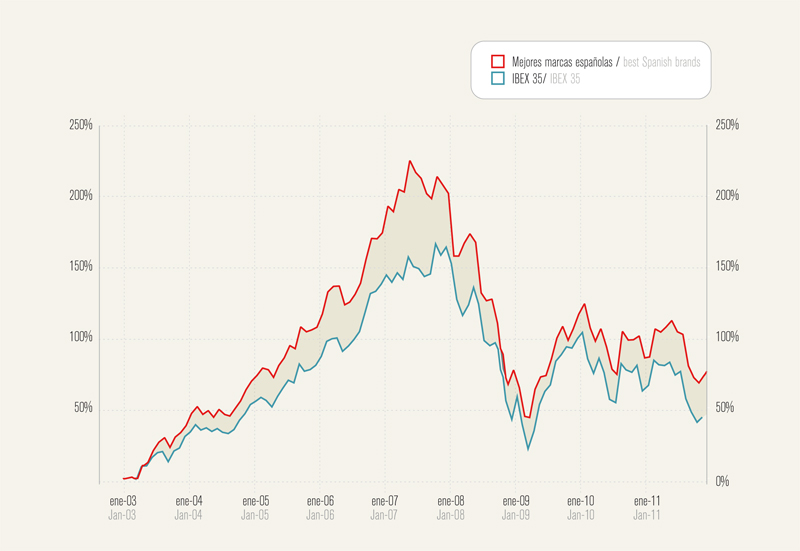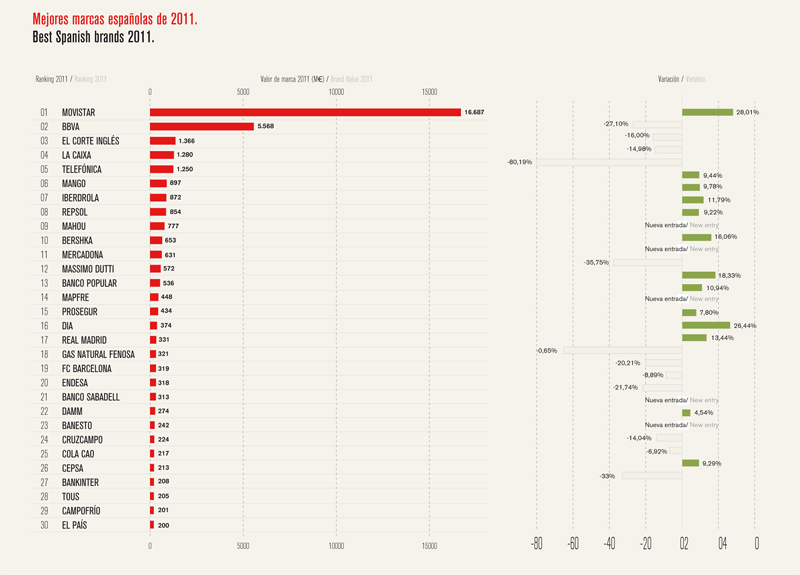There are several studies of reference that measure the value of international brands including those of the Reputation Institute, Fortune 500, Best companies to Work for and Best Global Brands, among others. Such studies can be a useful starting point when creating and managing a global brand.
The ranking of the 100 Best Global Brands allows us to extract the keys as to why some global brands grow successfully and why some fail to do so. The study has proved to be a real diagnosis of why brands are born, grow, reproduce and, in some cases, die, and how they do so. It is fascinating to see that if internationally established brands are not reorganised into areas such as relevance, differentiation and credibility, they end up losing status in their sector and ultimately, therefore, stop growing and disappear.
One of the keys to the success of companies that move up in rankings in the study and grow is the equal importance given both to assets such as employees and the business ethics that they defend. The reality is that consumers take into account the corporate social responsibility of the company from which they will buy the product. This means that companies are subject to increasingly demanding global standards of quality and commitment. A company’s reputation is at stake if it becomes apparent that it only seeks profit and does not take into account the economic, social and cultural environment in which it operates.
It is also essential to understand in the creation of a global brand that the brand is the most important intangible asset of a company and that brands must have a clear international vocation to fit into today’s competitive market. To achieve this, it is necessary to define the following: correct product selection, management and market research team, visual brand identity, consistency, implementation, positioning, international vocation, digitalisation and innovation.
Correct product selection, management and market research team
It is essential to properly define our product in the early stages of the development and growth of our global brand. We will not be able to reach our customers without a clear definition of who we are. It is also essential to make the purchasing decisions easier for our end consumers, expanding their range of well defined options. Our experience at Interbrand has taught us that “less is more”. A clear example of this is the brand Apple, which has a low number of products that are well organised and defined, and it has managed to position itself as a leader with a limited number of good quality products. Apple is also a clear example of a brand with a successfully applied brand strategy, as reflected in the ”Best Global Brands 2012” ranking in which it increased its brand value by 129% year-on-year.
Likewise, another fact just as important as the accurate definition of our product is the selection of the best team to manage our brand. A major global brand always has a great leader behind it to head up a suitable brand strategy. Proof of this are leading brands in their respective sectors with leaders such as J. P. Morgan, Henry Ford, Francisco González, Steve Jobs, Emilio Botín, Amancio Ortega and Mark Zuckerberg, among many others.
Choosing a team that is ready to manage our brand means that they will accompany us along the journey, defining its values and positioning. Moreover, it is essential that company employees have the brand internalised as they will be ambassadors for the brand, ensuring its successful transfer outside the company walls.
Appropriate language training is fundamental to achieve international presence. In Spain we have the added value of Spanish, the second most widespread language in the world by number of speakers and the second language in terms of international communication. If we also spoke good english, we could communicate with the whole world, which is vital to better sell our products in today’s competitive market.
Moreover, a well-defined brand will attract and retain the most talented human capital, which will result in a win-win situation both for the company and the employee. employees will feel proud to work for a strong brand and the company will benefit from having better trained and qualified workers to defend its brand.
Finally, it is important to properly select what markets to operate in, seeking competitive opportunities for our brand. While it is true that our Internet presence brings together all our foreign customers in one place, focus must be placed on our efforts in brand management in specific markets, developing a timeline with objectives clearly defined for each market. Therefore, we have to define where we are going to operate and what goals we want to achieve in each market.

Brand strategy must be in line with the business strategy
Positioning
Positioning is a fundamental pillar when establishing what role our brand will play in its sector, compared to its competitors.
It is extremely important that all companies (small and medium and large) are clear on what differential position they occupy within their market. To do this, it is always a useful exercise to identify the unique aspects of the brand compared to competition, and to analyse the distinctive attributes of the brand. At a minimum, our brand should have four attributes that clearly differentiate us from our competitors.
Returning to the Best Global Brands report and other studies of global brand value, it is important to see which brands have grown and improved their positions over the years, but also to see which brands have declined and lost value and why this has happened, to learn from these. We can learn a lot from success and failure stories and we can apply the lessons learned to our brands. The telecommunications and technology brands are perhaps the most well-known case studies of sectors undergoing rapid change.
It is an honour that two of our Spanish brands (Zara and Santander) appear in the “Best Global Brands 2012’ ranking, positioned among the top 100 in the world, and they are continuing to grow. Their presence in the study shows that, despite the difficult economic crisis which has engulfed Spain and affecting the banking and consumption sectors, in particular, these companies have demonstrated that their brand value remains high and continues to grow because the customer is the centre of their activity and they have a solid brand strategy aligned with their business strategy.
Creating a visual brand identity
Every great, consistent and solid brand must seek support and features that differentiate it from the competitors.
Searching for a unique colour, expressly creating photos and images for the brand, having a unique typography, a secondary graphics system, a unique colour spectrum or creating a particular sonic brand are just some of the aspects and traits that make up the visual identity of a brand. Our intention should always be to attract and retain, as far as possible, our customers, so that the sum of all these traits will clearly define the visual identity of our brand. This makes our identity recognisably visual. Once the brand is built by defining the specific features and attributes of our differentiating factors, brand communication must be consistent at all points of customer contact: stationery, retail, how our employees deal with customers, etc. so that we consistently convey who we really are.
Consistency
consumers have different buying habits according to their lifestyle, religion, age, socioeconomic status, among others, even within the same market. This fact is even more remarkable since the explosion of social networking and content viralisation as these encourage greater dispersal in consumption habits.
To create a strong global brand we must create brand consistency through a solid marketing and communication strategy, allowing us to reach our customers regardless of where they are, reflecting consistency in the principles and values that define us. To do this, advertising must be adapted for each market. In Interbrand, we believe the premise in the definition and management of a brand should be 70/30, 70% consistency and 30% innovation.
A business plan is also a must to comply with the consistency of our brand. Around 70-80% of companies without a business plan are not managing their brand well. It is always recommended that the brand strategy is in line with the business strategy.
To create greater consistency in our global brand, an annual marketing plan must also be designed, regardless of the marketing strategy followed (i.e. small budget, word of mouth strategy, brochures, social networks or just a website). Time must be spent preparing the plan as it is an integral part of the process, since, along with business and brand strategies, it allows us to project our brand more compellingly and clearly to our customers. We must also design actions we can carry out to reinforce our brand and we need to define in what primary and secondary markets they can be implemented and to focus our efforts on this, without losing sight of the objectives established for our brand.
Implementation
The implementation phase of a brand seeks continuity of the spirit of the brand at all points of contact. In the case of any airline, for example, all phases are important: the implementation of our brand in the online experience of buying tickets by the consumer (who seeks speed in comparison shopping, booking, good navigation by page etc.), dealing with the ground crew at the check-in and a good flight experience (through good service, entertainment, proper treatment of staff, good food, etc.). The brand experience must be all- embracing and positive for the customer at every point of contact.
International vocation
When creating a global brand it is essential to think big and not only focus on the domestic market, but define and aspire to all markets where our brand may reach. International vocation is one of the key rules that entrepreneurs must impose on their brand. Therefore, any brand that since the outset is not legally registered in all possible categories is a brand born somewhat amputated, with no future or ability to grow. To avoid this, it is best to look for a strategic partner to help us define the rules and categories that our brand may fall into and to defend it on an international level.

It is also imperative that employers are perfectly up-to-date in terms of market trends in their industry and consumer preferences. The reality is that the changing landscape in which we live, the “Generation Y”, and “Generation X” consumers and the baby-boomers, among others, are changing their purchasing decision habits. It is essential, therefore, to review these trends and to adjust the “uniqueness” of our brand to them. The digital age is the order of the day and so it is vital for companies to have a digital presence, not only owing to the fact that for global brands it will be a meeting point with customers anywhere in the world, but because the information about our consumers is on the Internet and social networks, for everyone to see. We must be smart in finding information and content and take advantage of the great benefits offered by digital media.
Returning to our most international businesses, Zara and Santander, their business strategies have a clear international vocation. Zara has shown interest in internationalising its brand not only by having physical presence with 1671 stores worldwide (excluding 192 Zara Kids and 325 Zara Home stores, according to Inditex), but also through its high investment in an online presence and providing sales services through its online store to an increasing number of countries. Santander, meanwhile, has 15,000 offices worldwide and is “multi-channel’, as its states on its website.
Digitalisation
Undoubtedly, the changing landscape of communication which we are experiencing has gradually forced brands to have an increasingly important presence on the Internet, and the impact of our actions on the Internet is now global. As explained in the cluetrain Manifesto: “the Internet is enabling conversations among human beings that were simply not possible in the era of mass media” and this benefits us in building a global brand. The paradigm shift in our media has caused the communicative exchange between the business and customer (known as “business-to-client” (B2c)) to no longer be unidirectional but bidirectional, meaning the business is able to respond to the customers’ needs because they have previously engaged in dialogue with them (‘business and client’ dialogue (B&c)). Social networks, for example, enable us to talk with our customers by listening to their opinions, sharing information and being able to find out what they need firsthand. However, our social media presence should always be a viable secondary strategy because a careless presence would have an impact on customer relationships and our reputation as a company. Internet and social networks
have also proven to be a useful tool to measure a factor as important as learning about customer satisfaction with our products and the service that we offer them.
While it is true that the web brings together all our customers onto one platform, regardless of where they are in the world, it is important to adapt to some extent the means of contact with our customers to their local needs, without losing the essence of who we are. The premise of “think global, act local” (the glocal phenomenon) is easier to implement in our brands through digitalisation, if we are to have an updated online strategy that is adapted to the needs and preferences of our customers. A notable example of “glocal action” is McDonald’s, which launched its ‘McIbérica burger to satisfy the needs and preferences of the Spanish market.
Innovation
finally, another aspect necessary in creating a global brand is innovation. This is what will allow us excel in today’s competitive market and to adapt to the times without becoming outdated. One of the ten attraction factors that Google gives for going to work in the company is its innovative character (‘Top 10 reasons to work at Google’, the company’s Linkedin profile).
Google says that even the best technology can be improved and it believes that the opportunities are limitless when creating more relevant, more useful and faster products. It is a good philosophy that should be applied to all our brands and, even more so, given that it comes from such a successful case study of business strategy and brand as Google.
An example of innovation (or lack thereof) is the case of mobile phone brands. Some 20 years ago, for instance, a lot of us used Motorola, the trend moved towards nokia, years later Blackberries came into fashion and today iPhones are the must have device owing to Apple’s current dominance in the market. Nokia and Motorola were unable to adapt to new customer requirements and were left behind. Similar examples can be found in the photography market, with the changeover from analogue to digital cameras and the advent of mobile phones with built-in cameras, or in the fleeting and changeable world of fashion (e.g. fumarel), among many others cases of companies that have folded or shrunk significantly over the years.
There is a lack of knowledge about the potential of Spanish companies
The correct management of our brand internationally is increasingly important in the growing global market in which we live. Learning how we can create a local brand, seeing it grow and developing it successfully in a global market is a must for any entrepreneur. Our Spanish brands must become increasingly present on the international scene since there is currently a lack of knowledge about the potential of our companies abroad and our entrepreneurial character is not being given its due. Our business reality as a country is very different from what is being presented today and we deserve a more just situation. Only by providing more information about how to manage our brands beyond our borders will we be able to work together.
It must be highlighted that, throughout the process of managing a successful brand, we need to focus more than ever on the consumer. This is our ultimate goal and the centre of our activity. Only by giving consumers exactly what they need and want can we grow together with them. consumers are the key to our future and they will give us the key to keep growing – if we listen to them.
Chairman of Interbrand Latin America and Iberia
